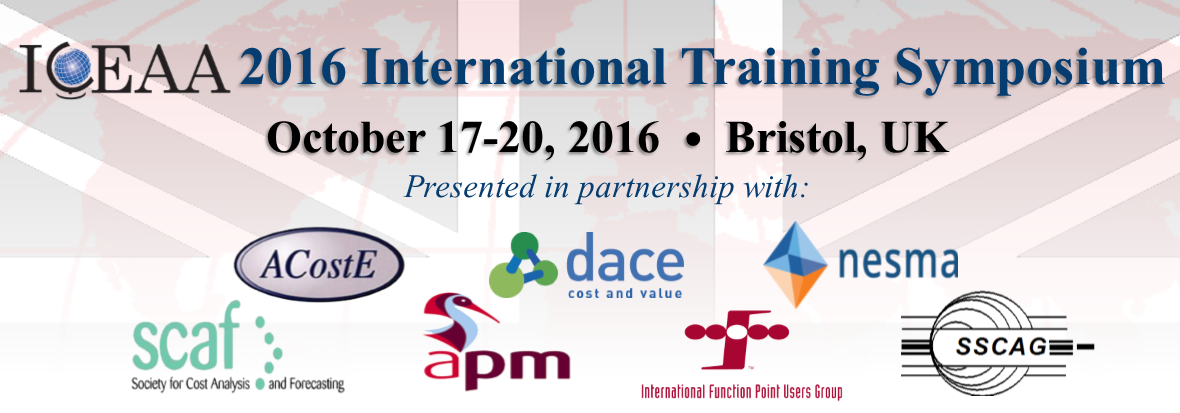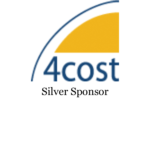
Session Descriptions Speaker Bios Keynote Presentations
Thanks to our Sponsors:

|
 |
||
 |
 |
Join us in the United Kingdom for the 2016 International Training Symposium featuring three days of peer-authored professional paper presentations and PCEA®/CCEA® preparation training during this unique opportunity to meet with friends and colleagues from cost communities around the globe.
Download the detailed schedule with speaker names and session titles (subject to change).
Best Papers and Best Presentation:
Based on the narrative papers provided, our committee of judges found two papers tied for the Best Paper of the International Training Symposium, with an additional Honorable Mention. The judges then rated the slide show presentations and named the winner of the Best Presentation:
Best Paper:
Measurement of Software Size: Contributions of COSMIC to Estimation Improvements (SW02)
Alain Abran
Charles Symons
Frank Vogelezang
This talk presents 1) an outline of the design of the 2nd generation COSMIC method for measuring a functional size of software; 2) industry evidence of its practical value in software project performance measurement and its accuracy in estimating; 3) an account of the method’s full automation, with very high accuracy, for real-time embedded software specified in Matlab-Simulink and developed through a world network of software contractors.
Paper: Measurement of Software Size: Contributions of COSMIC to Estimation Improvements (SW02)
Presentation: Measurement of Software Size: Contributions of COSMIC to Estimation Improvements (SW02)
Best Paper:
The Signal and the Noise in Cost Estimating (MM01)
Christian B. Smart
We seek to extract signal and eliminate noise when building models with historical data to predict future costs. One common problem is normalization, which is necessary when making comparisons but can inject noise when used in modeling. We discuss kernel smoothing and distribution fitting as ways to avoid overfitting peculiarities in historical data and the important issues of cross-validation and parsimony as ways to validate models and avoid the lure of overfitting.
Paper: The Signal and the Noise in Cost Estimating (MM01)
Presentation: The Signal and the Noise in Cost Estimating (MM01)
Honorable Mention:
NASA’s X-Plane Database and Parametric Cost Model V2.0 (GP08)
Steve Sterk
In 2015 the idea of creating an Armstrong X-Plane Cost Model was conceived. Initially the data being used was leveraged from Dr. Joe Hamaker’s Quick Cost v5.0 and verified and supplemented by Armstrong’s summer intern Aaron McAtee (PhD). After several peer reviews, it was suggested to go back and take a hard look at the data collected. Our objective is to produce an X-plane database that ensures that all the data is as accurate, traceable and far-reaching as possible.
Presentation: NASA’s X-Plane Database and Parametric Cost Model V2.0 (GP08)
Best Presentation:
Outing the Outliers (RA02)
Alan R. Jones
Inappropriate inclusion or exclusion of data that may or may not be regarded as outliers may make a project unachievable or uncompetitive. This paper looks at some of the issues involved and what tests are available to support an informed decision process rather than relying on a random guess on what is, or is not, an outlier. The paper will compare the performance of these tests against a number of sample data sets.
Paper: Outing the Outliers (RA02)
Presentation: Outing the Outliers (RA02)
Paper Presentations & Training:
The 36 presentations scheduled will cover a wide range of cost related topics and have been categorized into six topic tracks:
- Government Perspectives – A global view of cost estimating issues experienced by the British, Canadian, and the United States Governments.
- Management – Valuable topics for decision makers such as the value of R&D and using using public data to win proposals.
- Models & Methods – Featuring presentations describing ways to estimate the unique areas of our industry from grey water to 3-D printing.
- Risk Analysis – Topics on forecasting and uncertainty to help cost estimators determine the possible future economic state of a project and to minimize future negative unforseen effects.
- Space Systems – Presentations focused on state-of-the-art estimating techniques related to space systems.
- Software – Including topics to help cost estimators analyze, plan, and control their software projects.
For those who have been studying to take the PCEA® or CCEA® exam, the nine training courses being offered during the Symposium have been specifically structured to enhance and amplify your studies and provide expert insight on the content:
- Cost Estimating Techniques
- Data Collection & Normalization
- Learning Curve
- Data Analysis
- Regression/Parametric Analysis
- Cost/Schedule Risk Analysis
- Probability & Statistics
- Software Cost Estimating
- Cost/Earned Value Management


